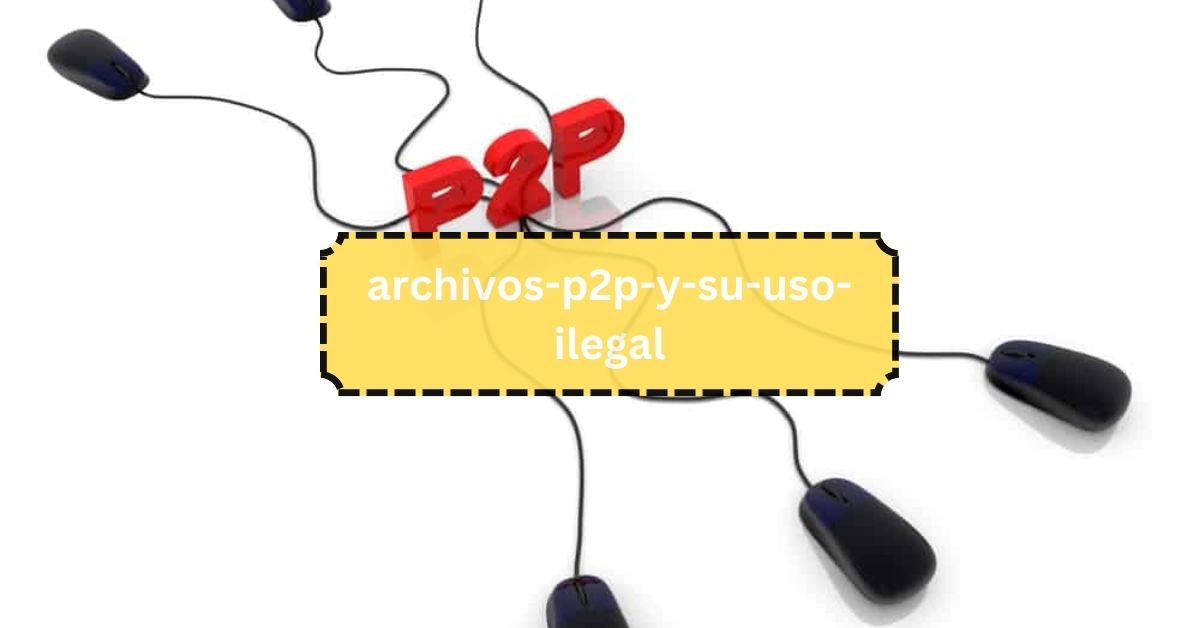Using “https://seguridadinformaticahoy.com/archivos-p2p-y-su-uso-ilegal/” opened up a world of file sharing, but I quickly learned about the risks of downloading copyrighted material illegally.
P2P file sharing, focusing on its legal and illegal aspects, especially regarding “https://seguridadinformaticahoy.com/archivos-p2p-y-su-uso-ilegal/”. In today’s digital world, sharing files over the internet is common, and P2P networks play a big role.
We’ll unravel the basics of P2P file sharing, its lawful applications, and why it sometimes veers into illegality. Whether you’re a novice or seeking to navigate the legal terrain, this guide offers a clear overview.
What is https://seguridadinformaticahoy.com/archivos-p2p-y-su-uso-ilegal/ P2P File Sharing?
Peer-to-peer (P2P) file sharing, as exemplified by the content on “https://seguridadinformaticahoy.com/archivos-p2p-y-su-uso-ilegal/”, refers to a decentralized method of distributing digital files among multiple users over a network without reliance on a central server.
In essence, it allows individuals, or “peers,” to directly exchange files with one another. This model diverges from the traditional client-server setup, where files are stored on a central server and accessed by clients.
The decentralized nature of P2P file sharing is significant. Instead of a central server being responsible for storing and distributing files, each user in a P2P network shares their files while simultaneously downloading files from others.
P2P networks like “https://seguridadinformaticahoy.com/archivos-p2p-y-su-uso-ilegal/” also boast scalability advantages. As more users join the network, they contribute additional bandwidth and resources, bolstering the network’s overall capacity.
Understanding P2P Files and Their Illegal Use on “https://seguridadinformaticahoy.com/archivos-p2p-y-su-uso-ilegal/!

P2P (peer-to-peer) files encompass various digital content, including e-books, multimedia such as music, movies, and video clips. These files are shared directly between users or nodes via a P2P network, without the need for a central server.
To engage in P2P file sharing, users utilize P2P client software, enabling their computers to connect to the P2P network. Within this network, individual users are referred to as peers. Peers establish connections with one another using TCP or UDP protocols, allowing them to request and share files seamlessly.
While P2P sharing offers convenient access to digital content, it has also gained notoriety within the pirate community. Many individuals utilize P2P networks, such as those discussed on “https://seguridadinformaticahoy.com/archivos-p2p-y-su-uso-ilegal/”, to distribute copyrighted material, such as music, movies, and TV shows, without obtaining proper authorization.
How P2P File Sharing Works on “https://seguridadinformaticahoy.com/archivos-p2p-y-su-uso-ilegal/”!
Peer-to-peer (P2P) file sharing operates on a decentralized network architecture, allowing individual computers (peers) to directly exchange files without relying on a central server.
Unlike traditional client-server models where files are stored on a central server and accessed by clients, P2P file sharing involves the distribution of files among multiple peers, with each peer acting both as a client and a server.
The process begins when a user wishes to share a file. Instead of uploading the file to a central server, the user’s computer becomes a node in the P2P network and makes the file available for sharing.
Other users within the network, known as peers, can then connect to this node and download the file directly from the user’s computer.
One of the most common protocols used for P2P file sharing is the BitTorrent protocol. When a user wants to share a file using BitTorrent, they create a small file known as a torrent file.
This torrent file contains information about the file being shared, including its name, size, and the locations of peers sharing the same file.
Read: Nysdcindx – Opportunities For Financial Growth!
How to Safely Use P2P File Sharing – Read Important Points!

P2P file sharing can be convenient, but it’s important to take precautions to protect yourself and your computer. Here are eight ways to stay safe:
Keep Security Software Updated: Ensure your computer’s security software, including antivirus and firewall protection, is up to date. This helps prevent malware from infecting your system through shared files.
Use Legal File Sharing Services: Stick to reputable P2P platforms that offer legal content downloads. Platforms like BitTorrent, Joost, Miro, Babelgum, and BBC iPlayer provide access to a wide range of legal content.
Scan Downloads for Threats: Before opening downloaded files, use your security software to scan them for potential threats. Quarantine or delete any files flagged as dangerous.
Avoid Copyrighted Material: Refrain from uploading or downloading copyrighted material without proper authorization to avoid legal repercussions.
Be Mindful During Installation: Pay close attention when installing P2P programs. Understand which folders on your computer will be shared publicly to avoid exposing sensitive data.
Close Connections When Not in Use: Always close P2P file-sharing programs when you’re finished using them to prevent unauthorized access to your shared files.
Avoid P2P File Sharing at Work: Unless it’s necessary for work purposes, avoid using P2P file-sharing programs on company computers, as it may violate company policies and pose security risks.
Educate Children about Risks: Teach children about the dangers of downloading files from the internet and encourage safe browsing habits. Implement parental controls and monitoring tools to supervise their online activities.
Identifying Illegal Activities with Archivos P2P on “https://seguridadinformaticahoy.com/archivos-p2p-y-su-uso-ilegal/”!
Copyright Infringement:
One of the most common illegal activities associated with Archivos P2P https://seguridadinformaticahoy.com/archivos-p2p-y-su-uso-ilegal/ is copyright infringement. Users may share copyrighted material such as movies, music, software, and books without proper authorization from the copyright holders.
Distribution of Illegal Content:
In addition to copyright infringement, Archivos P2P networks may also be used to distribute illegal or objectionable content, such as pirated software, pornography, or materials promoting hate speech or violence.
Read: Masake Y Jonsiki na Kamtaio Mama – Updates In 2024!
Malware Distribution:
P2P networks are sometimes exploited by malicious actors to distribute malware-infected files. These files may be disguised as legitimate content but contain harmful software designed to compromise users’ computers or steal sensitive information.
Fraudulent Activities:
Some individuals may use Archivos P2P https://seguridadinformaticahoy.com/archivos-p2p-y-su-uso-ilegal/ networks to engage in fraudulent activities, such as selling counterfeit goods, phishing scams, or identity theft schemes. Users should be vigilant and avoid interacting with suspicious files or individuals on P2P networks to protect themselves from falling victim to such scams.
Factors and Features of the Use of Archivos P2P – You Must Know!

- Decentralization:
Archivos P2P networks operate on a decentralized architecture, meaning no central server controls file sharing. This decentralization allows for greater resilience, scalability, and flexibility in file sharing.
- Efficiency:
P2P networks utilize a distributed approach to file sharing, allowing users to download files from multiple sources simultaneously. This swarming technique improves download speeds and reduces the burden on individual servers.
- Anonymity:
P2P networks offer a level of anonymity to users, as files are shared directly between peers without the need for intermediaries. While this anonymity can protect privacy, it also raises concerns about illegal activities and copyright infringement.
- Content Availability:
The availability of content on Archivos P2P https://seguridadinformaticahoy.com/archivos-p2p-y-su-uso-ilegal/ networks varies widely and depends on user participation. While some networks host a wealth of legal and authorized content, others may contain copyrighted material or illegal content.
- Legal Implications:
The use of Archivos P2P https://seguridadinformaticahoy.com/archivos-p2p-y-su-uso-ilegal/ networks raises legal concerns, particularly regarding copyright infringement and the distribution of illegal content. Users must understand the legal implications of sharing and downloading files through P2P networks to avoid legal consequences.
FAQs:
Is Archivos P2P https://seguridadinformaticahoy.com/archivos-p2p-y-su-uso-ilegal/ legal?
The technology itself is legal, but the content shared on P2P https://seguridadinformaticahoy.com/archivos-p2p-y-su-uso-ilegal/ networks may include copyrighted material, leading to potential legal issues.
How does Archivos P2P https://seguridadinformaticahoy.com/archivos-p2p-y-su-uso-ilegal/ work?
Archivos P2P https://seguridadinformaticahoy.com/archivos-p2p-y-su-uso-ilegal/ works by connecting individual computers (peers) to share files directly with each other. Users download files from multiple sources simultaneously, improving download speeds.
Is it safe to use Archivos P2P?
While Archivos P2P networks offer benefits like decentralization and efficiency, users should be cautious as they may encounter malware-infected files or illegal content.
Conclusion:
P2P https://seguridadinformaticahoy.com/archivos-p2p-y-su-uso-ilegal/ networks provide a decentralized and efficient method for direct file sharing among users. Despite their advantages like speedy downloads, users must consider the legal and ethical aspects.
Read Also:
- Density Of Copper – Access The Full Details Now In 2024!
- Tusc Co Craigslist – Staying Informed And Up-To-Date!
- Craigslist CO Springs Free -Discover The Facts Now!
- https://bajartiktoks.com/como-y-porque-reiniciar-el-algoritmo-de-tiktok/
- https://bajartiktoks.com/como-y-porque-reiniciar-el-algoritmo-de-tiktok/


























+ There are no comments
Add yours